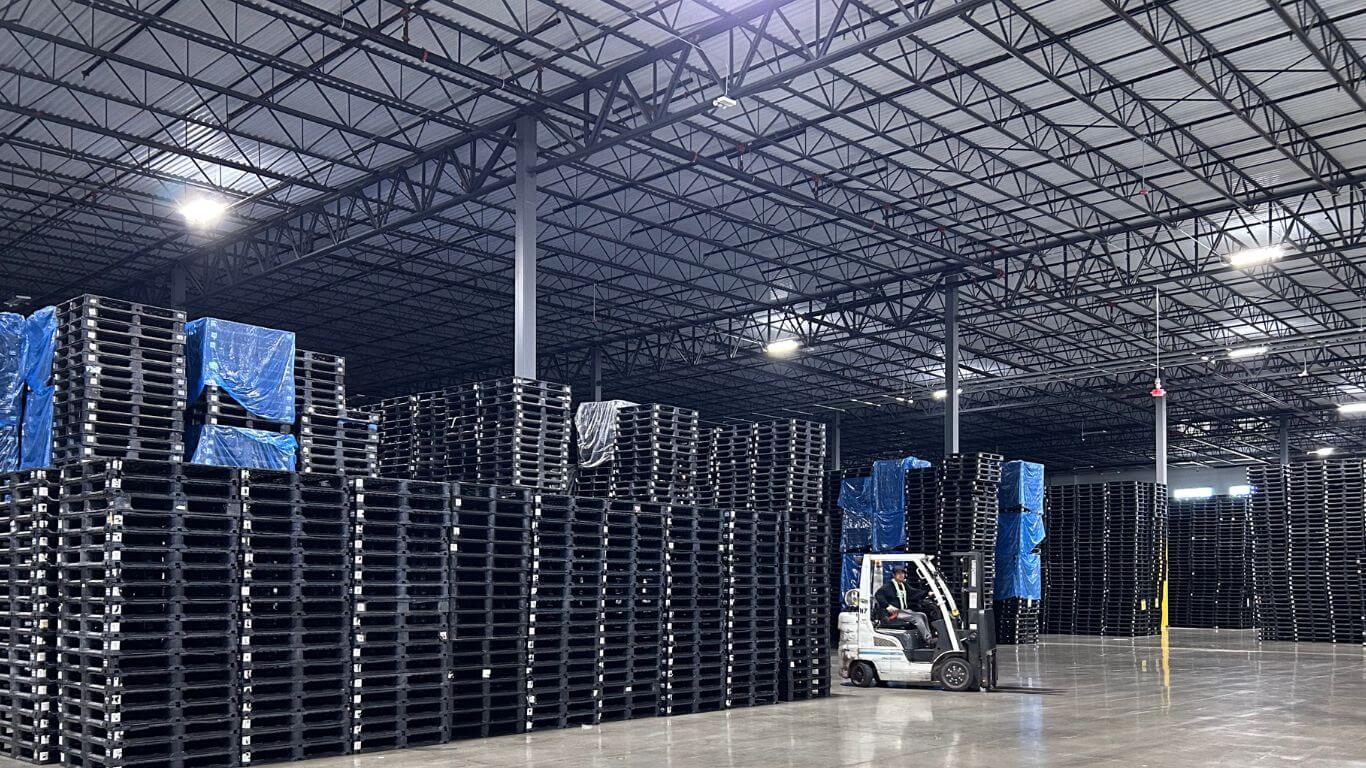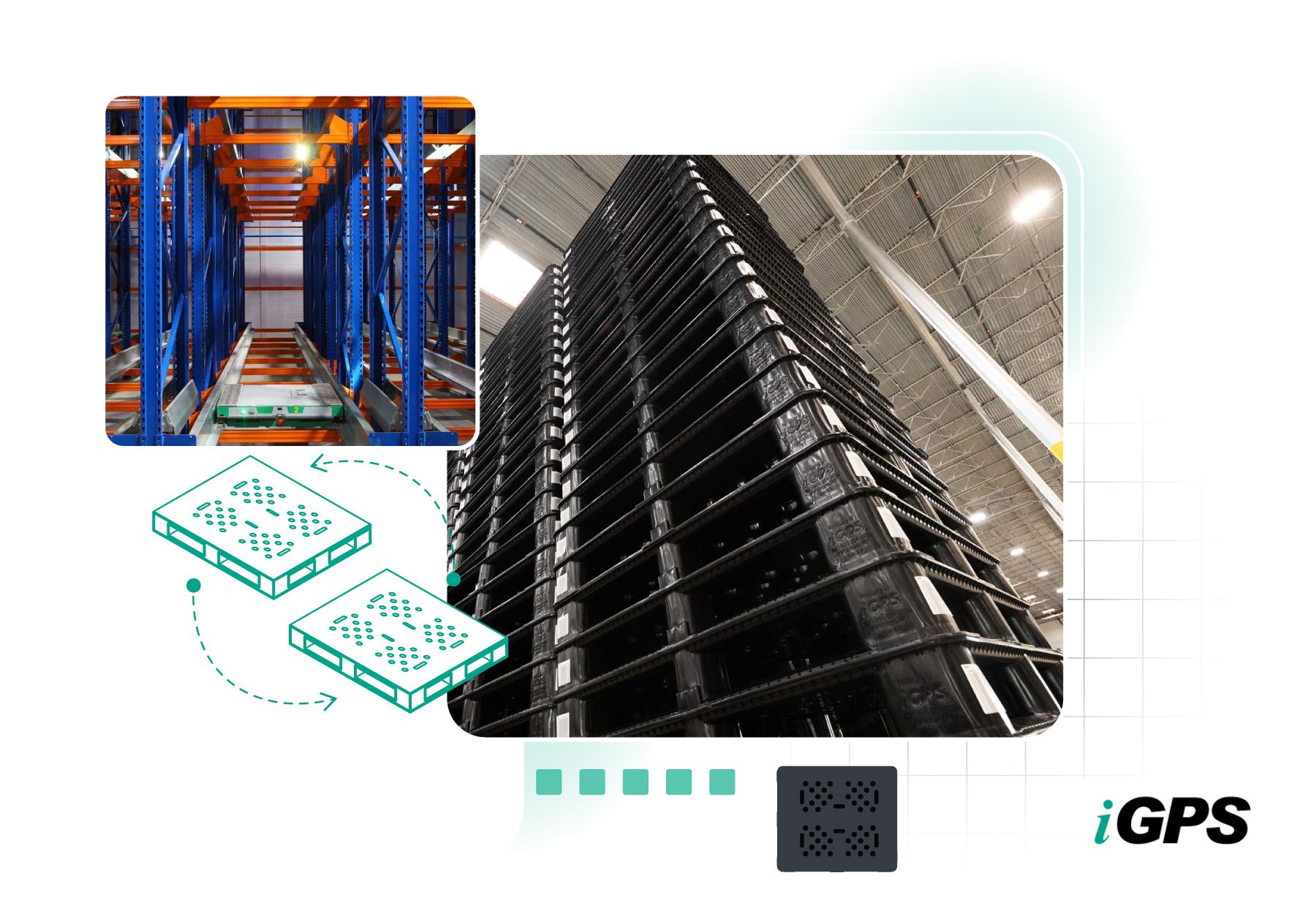Key Takeaways
- The modern supply chain demands consistency and efficiency.
- The shipping pallet is an important yet often overlooked player in the nationwide supply chain. The GMA or CBA pallet is the primary standardized format.
- The pallets get this name from the Grocery Manufacturers Association, which was renamed the Consumer Brand Association in 2020.
- These pallets are 48” by 40” and compatible with virtually all warehouses and automated environments.
- Consistent pallet dimensions ensure that no bottlenecks exist across the supply chain as pallets move from manufacturers, to distributors, to retailers.
- Plastic pallets, such as those offered by iGPS, offer distinct advantages due to their lighter weight, consistent dimensions, and environmental sustainability benefits.
Understanding GMA Pallets: Standard Sizes and Specifications Explained
Consistency and efficiency are among the cornerstones of an optimized logistics operation. A vital yet often overlooked asset, which plays a foundational role in the supply chain, is the shipping pallet. Pallets carry goods during storage and transport, which make them essential in every industry that requires distribution of physical goods. Among the various pallet types employed by the industry, the GMA pallet — now referred to also as the CBA pallet — is the primary standardized format across North America.
Understanding the specifications, features, and benefits of GMA/CBA pallets is crucial for supply chain leaders aiming to optimize their daily operations. And as more companies weigh the benefits of safety and sustainability, the choice between old-fashioned wood-block pallets and recyclable, lightweight plastic pallets has become a key consideration.
GMA Pallets: What Are They?
The term “GMA pallet” originated with the Grocery Manufacturers Association, a US-based trade group that has long represented the packaged goods and grocery industries. GMA pallets were adopted as the North American standard due to their uniform, consistent dimensions and suitability for large-scale distribution.
In 2020, the Grocery Manufacturers Association rebranded as the Consumer Brands Association (CBA) to reflect its broader mission beyond grocery products. While the brand has evolved, the impact and industry scope of the original GMA standard remains in effect. Because many within in the industry still refer to the pallet standard by their original name, both terms, GMA and CBA, are often interchangeably used to refer to pallets.
Sizes and Specifications of GMA/CBA Pallets
Standardization is at the core of the GMA/CBA pallet’s value to the industry. These pallets should be 48 inches long by 40 inches wide. These dimensions have become the default for grocery, retail, and consumer packaged goods shipments because the pallet size can be consistently accommodated in most transport, storage, and automated environments.
GMA/CBA pallets usually feature seven top deck boards and five bottom deck boards. They are designed for four-way entry, meaning that forklifts and pallet jacks can access them from any side. Their load capacity is robust, with most pallets handling around 2,500 pounds when in motion (dynamic load) and up to 5,000 pounds when static (stationary load). More durable plastic pallets, such as those made by iGPS Logistics, can accommodate 5,000 pounds in motion and 30,000 pounds when static and evenly distributed.
Because they follow such consistent structural dimensions and guidelines, GMA/CBA pallets help reduce variability in shipping and warehousing as well as within automated environments. This in turn reduces handling time and risk of products, pallet, and equipment damage while improving safety.
GMA/CBA Pallet Features
Beyond their consistent size and durability, GMA/CBA pallets are also valued for their reliability and their versatility in the supply chain. They can be used for both one-way shipments and within pallet pooling ecosystems, and their four-way entry improves handling efficiency as well as compatibility with numerous facility configurations.
Many GMA/CBA pallets are designed to be repairable. For example, if a wood pallet deck board breaks or a stringer becomes damaged, repairs can often be made quickly and affordably. Plastic pallets, meanwhile, are recyclable, which promotes “cradle-to-cradle” sustainability. They also tend to be more durable than wood, able to withstand more trips through the supply chain.
These consistent dimensions also make them more compatible with warehouse automation systems. As more facilities implement automated storage and retrieval systems and robotic palletizers, the need for precise and dependable pallet sizing becomes even more critical. Plastic pallets make this predictability even more precise, because they do not absorb moisture, which can change a pallet’s size and weight.
Why Consistent GMA/CBA Pallet Dimensions Are Important
The uniformity of GMA/CBA pallets is more than just a helpful advantage — it’s an absolute necessity for efficient modern logistics. When each pallet follows the same structural blueprint, supply chain operations can run faster, more safely, and with fewer opportunities for error.
Consistent sizing, for example, ensures maximum interoperability. Pallets typically pass through multiple hands, including manufacturers, carriers, distributors, retailers, and depots, and must be compatible with each system. Any variation could cause a bottleneck somewhere along the chain.
Standard dimensions also limit the possibility of product damage. Uniform pallets stack evenly, sit securely within trailers and storage facilities, and don’t leave gaps that allow products to shift or topple in transit.
Handling speed is also improved by consistent GMA/CBA standards. Forklifts and pallet jacks are often calibrated for specific pallet sizes, for example. Uniform dimensions means that equipment operators don’t have to waste time adjusting or repositioning loads.
Lastly, standard-sized pallets make it easier to optimize warehouse space. Whether it’s the number of pallets that fit inside a trailer or the maximum vertical stacking height in a facility, standard pallet sizing allows supply chain leaders to plan their operations efficiently.
Wood vs. Plastic Pallets
For decades, wood was the dominant material for GMA/CBA pallets. Wood is readily available, was traditionally affordable (although this has changed in recent years due to surging lumber prices), and is repairable.
However, wood-block pallets have their limitations. They are subject to splintering, loose nails, moisture absorption, and pest infestation. In industry verticals where hygiene is critical, such as pharmaceuticals and food production, these factors can pose health hazards while also creating a mess that consumes worker time and can jam palletizers and other equipment. Nails and splinters pose a threat to workers, too. Wood pallets can also be inconsistent in weight, especially if exposed to moisture or humidity. This can affect shipping costs or create issues in automated systems, which may reject a pallet outright for not meeting the appropriate standards.
For these and other reasons, plastic pallets have rapidly gained popularity as an alternative, offering long-term advantages in durability, cleanliness, and precision as well as significant sustainability benefits.
Why Choose iGPS Plastic Pallets?
Choosing GMA/CBA-compliant plastic pallets from iGPS Logistics over wood depends on an organization’s supply chain goals and environment. For companies prioritizing sanitation, plastic pallets are far easier to clean and sanitize. That makes them ideal for food, beverage, and healthcare logistics, where contamination can have serious consequences.
Plastic pallets also last longer. In fact, in a pallet pooling ecosystem, the average lifespan of an iGPS pallet is about 100 trips, making them four times as durable as wood (actual, not lab-tested).
From an environmental sustainability perspective, iGPS plastic pallets can be fully recycled at the end of their lifespans. This reduces waste while improving their environmental impact. The fact that plastic pallets are lighter and consume less fuel during shipping (therefore emitting less greenhouse gas emissions) is yet another sustainability advantage.
Still another key advantage is compatibility with automation. iGPS plastic pallets are precision-molded with tight tolerances, offering consistent dimensions and flat surfaces that make them well-suited for robotic handling systems. This precision can help reduce downtime and equipment jams. And still another benefit is that their light weight and absence of nails and splinters makes plastic pallets safer for both workers and goods.
Companies focused on safety, hygiene, sustainability, and long-term operational efficiency are finding that GMA/CBA-standardized plastic pallets from iGPS offer compelling benefits.
The GMA/CBA pallet remains a crucial player in the supply chain efficiency mix, offering both the consistent standardization and high-quality reliability that the modern logistics environment demands. As the industry continues its inevitable evolution and increases its adoption of automation, the choice of pallet materials and the advantages of plastic pallets become more serious considerations.
Understanding the important role of standardized GMA/CBA pallets and the myriad advantages of plastic pallets can help logistics leaders make smarter, more sustainable, and more cost-effective decisions. The pallet may be a simple shipping platform at its heart, but the vital part it plays in the national and global supply chain is increasingly complex.
Companies focused on optimizing their supply chain operations count on durable, lightweight iGPS plastic pallets for their shipping needs. iGPS pallets are fully compliant with GMA/CBA standards and offer advantages over wood. For more information, contact us at 1-800-884-0225, email a specialist at switch@igps.net, or visit our contact page.



